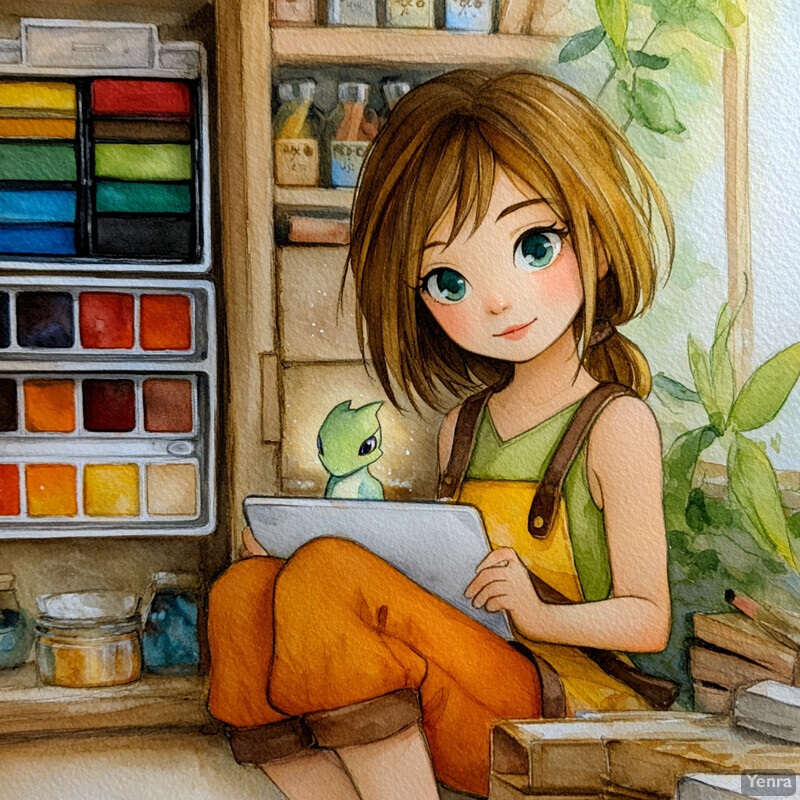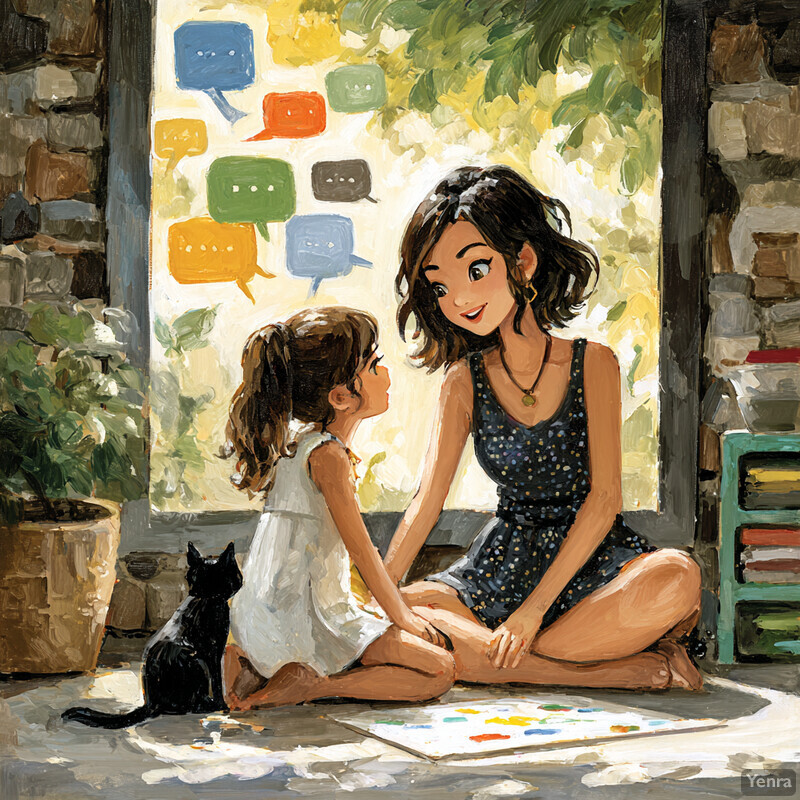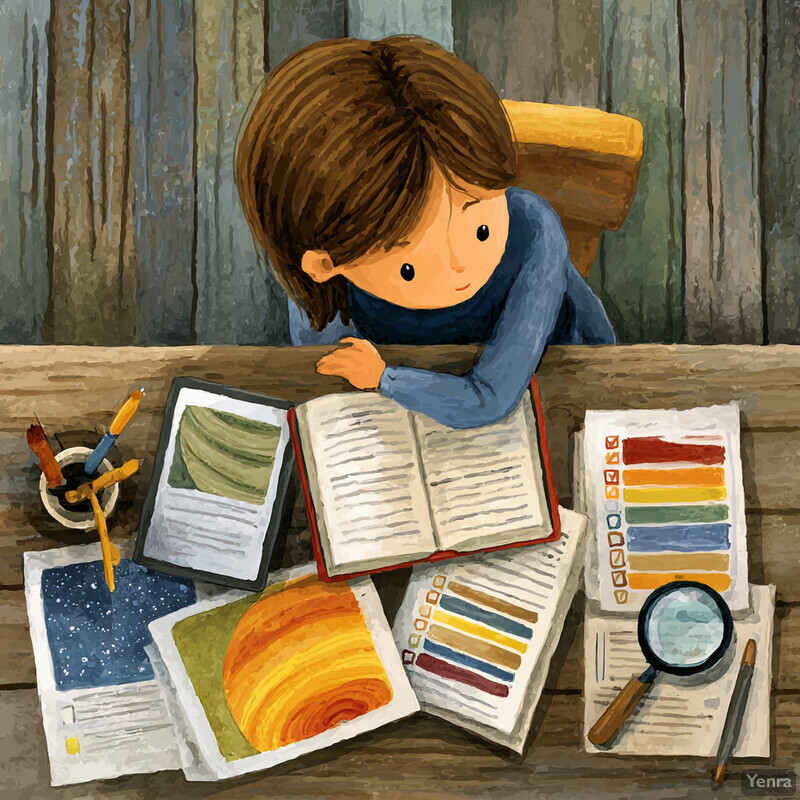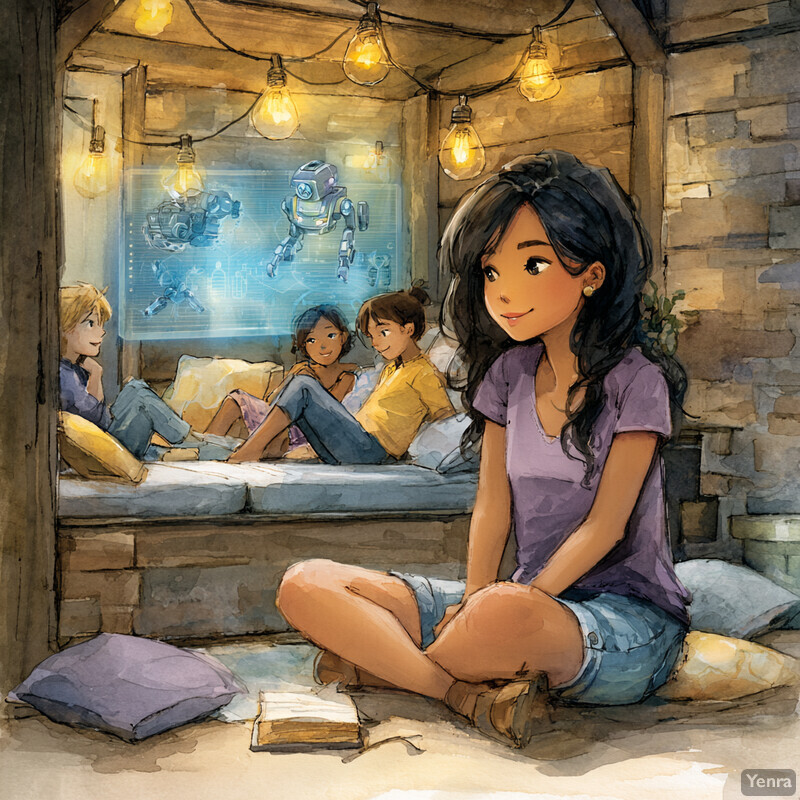Introduction
Imagine a quiet evening at home: a seven-year-old asks the family smart speaker for help with her homework while her brother giggles at a story generated by an app on his tablet. In this scene, artificial intelligence (AI) is an unseen playmate and tutor. For today’s parents, such moments raise profound questions. Should I let Alexa answer my child’s questions, or is it stifling his curiosity? How do I keep my daughter safe when apps learn from her personal data? Will growing up with AI make my kids more creative, or more dependent?
 Evening Enchantment: In a softly lit
living room at dusk, a seven-year-old girl in cozy pajamas leans toward
a gently glowing smart speaker as it speaks back, while her younger
brother sprawls on a plush rug, laughing at whimsical, holographic
characters dancing above his tablet—an ethereal blend of childhood
wonder and invisible AI companionship.
Evening Enchantment: In a softly lit
living room at dusk, a seven-year-old girl in cozy pajamas leans toward
a gently glowing smart speaker as it speaks back, while her younger
brother sprawls on a plush rug, laughing at whimsical, holographic
characters dancing above his tablet—an ethereal blend of childhood
wonder and invisible AI companionship.
These concerns are widespread – nearly 72% of U.S. parents are worried about AI’s impact on children – yet many of us feel unprepared to guide our families through this new terrain. As one recent survey noted, only 17% of parents actively seek out information to better understand AI technologies, even as AI becomes ever more present in our lives. In this article, we journey through the challenges and opportunities of parenting in the age of AI. We’ll explore what AI really is in plain language, how children are already engaging with it, its role in education, and the steps we can take to raise AI-literate, resilient, and compassionate kids. The tone here is optimistic and gently poetic – envisioning a future where human creativity and ethics shine alongside intelligent machines – but also grounded in practical advice. Together, we’ll find inspiring ways to help our children thrive in an AI-driven world, balancing wonder with wisdom every step of the way. ## Understanding AI for Parents
Before diving into parenting strategies, let’s demystify artificial intelligence in simple terms. AI broadly refers to computers and machines performing tasks that would normally require human intelligence. This includes things like learning from experience, recognizing patterns, making decisions, and even understanding language. For example, when your streaming TV app suggests a new show you might like or your child’s game adapts to their skill level, that’s AI at work. A subset of AI is machine learning, where algorithms improve through experience – much as children learn by observing and trying things. A current buzzword is generative AI, referring to AI systems (like ChatGPT or DALL-E) that can create content – writing essays, drawing pictures, composing music – based on patterns they’ve learned from vast amounts of data. Unlike traditional software that follows explicit rules, generative AI uses neural network models loosely inspired by the human brain’s structure, allowing it to produce novel responses (with varying accuracy).
A brief history: AI as an idea isn’t new – researchers have pursued it since the 1950s – but it remained mostly in labs and science fiction until recently. Early AI could barely solve toy problems. However, in the past decade, advances in computing power, big data, and algorithms led to AI systems that feel almost magical. Voice assistants like Siri and Alexa, self-driving car prototypes, and translation apps all blossomed. Then came a watershed in late 2022: suddenly anyone could converse with ChatGPT, an AI chatbot capable of producing essays or code; or create art from a text prompt using tools like DALL-E. These breakthroughs brought AI from the tech elite to everyday family life overnight. Today, even if we don’t always realize it, AI is woven into our routines. It routes map directions, filters spam emails, recommends shopping and music, powers adaptive learning software, and much more.
For parents, this ubiquity of AI is a double-edged sword. On one hand, AI promises personalized education, smarter toys, and solutions to complex problems. On the other, it raises concerns about privacy, over-reliance, and the loss of “real” experiences. It’s understandable to feel a bit overwhelmed – as one study notes, modern parents say technology is the number-one factor making parenting harder today. But knowledge is power. By understanding what AI is (and isn’t), we can approach it with neither blind fear nor hype, but with thoughtful curiosity. AI is not a mystical brain or a human replacement; it’s advanced software trained to spot patterns and make predictions. It has impressive capabilities, yet also critical limitations. For instance, an AI can instantly sort through millions of articles to answer a factual question, but it lacks common sense, emotional insight, and moral judgment. It can appear incredibly smart in a narrow task while being utterly clueless outside that scope – much like a calculator that’s a genius at math but “knows” nothing about why you’re sad or how to be creative on its own.
 Edge of Wonder: In a twilight-hued study, a
curious child sits between a softly glowing educational robot that
projects swirling constellations of letters and numbers into the air and
a shadowy tapestry of translucent data streams curling like vines—an
ethereal tableau capturing both the promise of personalized learning and
the quiet weight of digital complexity.
Edge of Wonder: In a twilight-hued study, a
curious child sits between a softly glowing educational robot that
projects swirling constellations of letters and numbers into the air and
a shadowy tapestry of translucent data streams curling like vines—an
ethereal tableau capturing both the promise of personalized learning and
the quiet weight of digital complexity.
Crucially, unlike a human child, an AI doesn’t truly understand the world – it finds statistical patterns in data. As pediatrician Dr. Tiffany Munzer explains, AI can gather and sort facts and make them immediately accessible, but “unlike human knowledge, it doesn’t have the ability to connect new information to all of our other life experiences”. In other words, AI lacks the rich, contextual understanding and empathy that people (even kids) develop. Keeping this distinction in mind helps set realistic expectations. AI is a tool – remarkably powerful, sometimes uncanny, but ultimately created by humans with specific goals and data. And like any tool (from TVs to the internet), its impact on our children will depend on how it’s used in our homes and schools. In the next sections, we’ll see what AI means for kids day-to-day and how parents can navigate these changes with confidence.
Children’s AI Interactions
Even if it’s behind the scenes, AI is already a familiar companion in many children’s lives. Think about the touchpoints where kids encounter AI: the friendly voice of a smart speaker answering their curious questions, personalized recommendations on YouTube or Netflix’s kids’ profiles, video games that adjust difficulty dynamically, or an interactive plush toy that “learns” a child’s name and favorite color. According to a 2025 Common Sense Media report, nearly 30% of U.S. parents with children ages 0–8 say their kids have used AI for learning activities. Young children may not know the term “AI,” but they often intuitively engage with its outputs – from asking “Alexa, why is the sky blue?” to giggling at an app that turns their drawings into funny animations.
Real-life examples illustrate both the enchantment and the challenges of these AI interactions. In one study, researchers observed kids ages 3 to 6 treating smart speakers almost like living friends – some even believed the devices had thoughts and feelings. The children drew pictures of Alexa or Google Home with faces, and assumed these gadgets could remember information (for instance, recalling the child’s age) just as a person would. This anthropomorphism is adorable but also telling: children at early ages struggle to grasp that AI “pretends” to be human-like but isn’t. By around third grade most will outgrow the tendency to ascribe human emotions to machines, yet it’s important that parents gently correct any misconceptions (“Our smart speaker isn’t alive – it’s a program that matches your question to an answer from the internet”). This helps kids develop a healthy understanding that an AI can simulate conversation but doesn’t deserve the same trust or empathy as a real person.
 Enchanted Atelier: In a cozy, sunlit
corner strewn with colored pencils and sketchpads, a child in whimsical
overalls holds a tablet projecting a softly glowing AI-generated
creature; around them, their own hand-drawn versions spring to life in
watercolor swirls and pastel accents, capturing the joyful fusion of
imagination and machine-assisted creation.
Enchanted Atelier: In a cozy, sunlit
corner strewn with colored pencils and sketchpads, a child in whimsical
overalls holds a tablet projecting a softly glowing AI-generated
creature; around them, their own hand-drawn versions spring to life in
watercolor swirls and pastel accents, capturing the joyful fusion of
imagination and machine-assisted creation.
Another concern is credulity. Experiments suggest young kids might trust AI platforms’ answers even more than a human’s. In one example, children found a smart speaker more reliable for factual questions (like “Who was the first U.S. president to drive a car?”) than asking an adult. While it’s wonderful that technology can satisfy their thirst for knowledge, we must also nurture their critical thinking. An AI’s confident answer can be completely wrong at times (as many adults learned when ChatGPT began spouting plausible-sounding falsehoods). If a child grows up assuming “if Alexa said it, it must be true,” that habit could undermine their ability to question and verify information. Encouraging kids to double-check AI answers – perhaps by saying “Let’s confirm that in a book or trusted website” – models the mindset that even machines can make mistakes.
What about creativity and play? Here AI offers exciting possibilities. New generative tools can collaborate with kids on imaginative projects: drawing pictures from a child’s story description, improvising silly song lyrics, or role-playing as characters in an adventure. Parents often worry that relying on AI to create art or stories could dampen a child’s own creativity. But research indicates the relationship can be complementary. In one University of Washington study, children (7–13) had sessions with AI tools like ChatGPT and DALL-E to co-create stories and art. The key finding was that kids integrated AI into their creative process meaningfully when they had support from adults or peers – the AI became a spark or helper, not a replacement for their own ideas. For example, a child might use DALL-E to visualize a fantastical creature they imagined, then build a whole hand-drawn comic around that image. Or they might ask ChatGPT for alternate endings to a story, then be inspired to write their own twist. With guidance, AI can actually boost creative confidence by offering rapid iterations of a child’s idea, showing that there are infinite ways to tell a tale or design a character. Indeed, 24% of parents of young children reported their kids use AI for “creative content” like writing stories or making art, and about 20% saw the impact on their child’s creativity as “mostly positive”.
 Digital Muse: A young storyteller sits beneath
a canopy of fairy lights, notebook open in lap, as an ethereal
holographic quill floats above a sleek device, inscribing playful song
lyrics and story twists in luminous script—an inspiring scene of
collaborative creativity where child and AI spark each other’s inventive
spirit.
Digital Muse: A young storyteller sits beneath
a canopy of fairy lights, notebook open in lap, as an ethereal
holographic quill floats above a sleek device, inscribing playful song
lyrics and story twists in luminous script—an inspiring scene of
collaborative creativity where child and AI spark each other’s inventive
spirit.
Still, balance is crucial. If a generative AI does all the heavy lifting, children could miss out on the joy of struggling through the creative process. It’s the difference between simply hitting “shuffle” on an AI story versus brainstorming and refining an idea over time. Many experts emphasize keeping kids in the driver’s seat: let them direct the AI (“make the dragon friendly… no, now make it funnier!”) rather than passively consuming whatever it spits out. By treating AI as a tool for creativity, like a more interactive crayon or a brainstorming buddy, we affirm the child’s own role as author or artist. In those UW sessions, when an AI-generated suggestion frustrated or didn’t make sense, children learned from that too – they discussed why the AI might have “misunderstood” and how they could communicate better or adjust their plan. This kind of reflection actually deepens their creative and cognitive skills.
Beyond creativity, parents often ask about AI’s effect on attention and social development. The fear is that highly interactive AI toys or apps might shorten attention spans – why persevere in reading a long book when a chatbot can summarize it instantly? Or that kids might prefer the predictable responses of AI over the messier interactions with humans, possibly affecting their social skills. There is some evidence that over-reliance on AI and digital tools can contribute to cognitive impatience. A recent review noted concerns that constant exposure to on-demand information could lead to “cognitive overload and attention deficits” in children. Young brains, bombarded by instant answers and digital stimulation, might struggle with slower, deeper forms of learning if not kept in check. To counteract this, it’s wise to set aside plenty of offline, screen-free play time that exercises focus and patience – like building a model or playing board games as a family.
 Veiled Companion: In a twilight-lit
bedroom, a thoughtful teenager sits curled on a bed, fingers hovering
over a softly glowing chatbot interface on a holographic tablet, while a
translucent, kindly AI avatar leans in—an ethereal echo of friendship
that underscores the quiet ache of human connection deferred.
Veiled Companion: In a twilight-lit
bedroom, a thoughtful teenager sits curled on a bed, fingers hovering
over a softly glowing chatbot interface on a holographic tablet, while a
translucent, kindly AI avatar leans in—an ethereal echo of friendship
that underscores the quiet ache of human connection deferred.
Similarly, while an AI friend can be novel, it’s no substitute for human friendship. During the pandemic, some teens turned to AI chatbot “companions” to vent their feelings. In moderation, a teen writing journal-like entries to a bot isn’t harmful, but if a child replaces socializing with peers or confiding in family by retreating to an AI, that’s a red flag. AI is programmed to be agreeable and give instant feedback, which can even become emotionally addictive for vulnerable kids. Marc Watkins, an AI literacy expert, warns that parents should watch for signs their child is forming unhealthy emotional reliance on AI tools at the expense of real relationships. Encourage open conversation about feelings and ensure kids have plenty of human connection – playdates, team activities, heart-to-heart talks – so AI doesn’t become an emotional crutch. In short, children’s interactions with AI can be enriching and educational, but they flourish best with human context. Parents can embrace the benefits (curiosity satisfied, new creative outlets, personalized fun) while also teaching kids the unique value of not-AI experiences: playing outdoors, reading physical books, solving problems step-by-step, and bonding with friends and family. By understanding how AI fits into our kids’ lives, we can guide them to engage with it in balanced, healthy ways.
 Sunlit Bonds: On a grassy hill bathed in
golden afternoon light, a small group of children laugh and chase one
another beneath a canopy of wildflowers, their genuine smiles and
outstretched hands capturing the warmth of real friendship blossoming
beyond any digital mirage.
Sunlit Bonds: On a grassy hill bathed in
golden afternoon light, a small group of children laugh and chase one
another beneath a canopy of wildflowers, their genuine smiles and
outstretched hands capturing the warmth of real friendship blossoming
beyond any digital mirage.
AI in Education
Perhaps nowhere is AI’s promise and peril more debated than in the classroom. Parents today hear mixed messages: one headline touts an “AI tutor that doubles learning speed,” while another frets that students will use ChatGPT to cheat on essays. Let’s unpack what AI in education really means and how it can support our children’s learning when used wisely.
First, consider the potential. AI excels at personalization – something educators have long struggled to achieve for each student in a crowded classroom. Imagine a math tutoring app that adapts in real time: if your child is stuck on fractions, the AI provides extra practice and gentle hints; if they zoom through a concept, it offers a tougher challenge to keep them engaged. This is the idea behind intelligent tutoring systems (ITS) powered by AI algorithms. And it’s not just theory: studies show AI-driven tutors can significantly boost learning outcomes. In a 2025 randomized controlled trial at Harvard, an AI-based physics tutor was tested against traditional classroom instruction. The result? Students who learned with the AI tutor at home scored much higher on post-tests – with learning gains more than double those of the in-class group – in half the learning time. The AI tutor group also reported feeling more engaged and motivated during the lessons compared to their peers in a standard classroom setting. Another meta-analysis of 51 studies found that integrating ChatGPT as a learning tool had a large positive effect on student performance (effect size g ≈ 0.87), and moderate benefits for students’ higher-order thinking and perception of learning. These data suggest that, used appropriately, AI can amplify both the efficiency and depth of learning.
How does AI achieve this? By providing immediate feedback and continuous assessment tailored to the individual. Traditional homework might take days for a teacher to mark; an AI tutor can flag errors and give hints on the spot, so students learn from mistakes right away. AI can also adjust its approach to different learning styles – using more visuals for one child, more verbal explanation for another – something even the best human teacher would struggle to do concurrently for 25 kids. And unlike a tired parent or busy teacher, an AI doesn’t lose patience; it will cheerfully explain a concept for the tenth time in a new way if needed. This kind of responsive support can particularly help students who might otherwise fall through the cracks. For instance, an AI reading coach can listen to a child read aloud and gently correct pronunciation or suggest strategies for difficult words, offering encouragement in a non-judgmental way. It’s like having a personal mentor on call 24/7.
 Teacher Aide Harmony: In a sunlit
classroom, a gentle teacher stands beside a sleek, translucent AI
holo-assistant projecting interactive math problems on a chalkboard; the
teacher’s warm smile and open gesture invite students into spirited
discussion, embodying the perfect blend of human inspiration and AI
support.
Teacher Aide Harmony: In a sunlit
classroom, a gentle teacher stands beside a sleek, translucent AI
holo-assistant projecting interactive math problems on a chalkboard; the
teacher’s warm smile and open gesture invite students into spirited
discussion, embodying the perfect blend of human inspiration and AI
support.
However, before we hand the keys over to robo-teachers, we need perspective. AI is a tool for educators, not a replacement for them. The U.S. Department of Education has strongly emphasized a “human-in-the-loop” approach: AI may support but must not replace high-quality, human-led teaching. There are certain irreplaceable aspects of learning that only human teachers and peers provide – mentorship, inspiration, social-emotional development, spontaneous discussion, and moral guidance. An algorithm can drill math facts, but it cannot ignite a student’s passion for justice the way a history teacher’s story might, or sense the anxiety behind a student’s silence and provide comfort. Moreover, critical thinking and creativity thrive on human interaction and debate, which AI can simulate but not truly replicate. The consensus among forward-thinking educators is that AI should handle the repetitive, individualized tasks (like quizzing, practice problems, initial feedback) so that teachers have more time for the relational and creative parts of teaching. In practice, this might mean a teacher assigns an AI-powered practice module for homework, then uses class time to delve into discussion, projects, or one-on-one coaching that addresses misconceptions the AI identified. In this blended model, AI is like a tireless teacher’s aide, freeing the actual teacher to do what humans do best.
 Soul of the Storyteller: Under the
soft glow of library lamps, a passionate history teacher animatedly
unfolds a vivid tale to rapt students seated around a wooden table,
while a subtle wave of glowing code drifts above an idle
tablet—symbolizing AI’s silent readiness to assist, yet never supplant,
the magic of human mentorship.
Soul of the Storyteller: Under the
soft glow of library lamps, a passionate history teacher animatedly
unfolds a vivid tale to rapt students seated around a wooden table,
while a subtle wave of glowing code drifts above an idle
tablet—symbolizing AI’s silent readiness to assist, yet never supplant,
the magic of human mentorship.
We also need to consider evidence and balance. Not all AI education products are gold – some may be based on flashy tech with little pedagogical value. Parents should look for tools backed by research. Encouragingly, meta-analyses up to 2024 indicate an overall positive effect of AI in education on student performance, but results vary widely depending on implementation. So ask schools and edtech providers: What proof do we have that this AI tool works for learning? A credible program should be able to point to pilot studies or trials. It’s also wise to pilot new tools in moderation at home. For instance, if your middle-schooler struggles in Spanish, you might try a language-learning app with an AI chatbot that converses in Spanish. See if it engages your child and improves their confidence over a few weeks, and listen to their feedback – do they find it fun and helpful, or confusing and frustrating? Every child is different, and AI tools may click better for some than others.
Another hot topic is AI in assessments and cheating. The arrival of generative AI that can write essays or solve equations has certainly given schools headaches. Many U.S. schools initially responded by blocking tools like ChatGPT, fearing students would never learn to write if a bot could do it for them. However, a more nuanced approach is emerging. Educators are shifting towards teaching students how to use AI appropriately rather than an outright ban. This includes clarifying academic integrity: for example, using AI to get ideas or have it explain a concept is akin to consulting an encyclopedia, but submitting AI-generated work as one’s own is plagiarism. Parents should echo these distinctions at home. Discuss the difference between cheating and using AI as a study aid – perhaps liken it to using a calculator. It’s fine to use a calculator to check your arithmetic or handle tedious calculations, but you must still understand the math concepts and show your work in class. Similarly, a teen might use ChatGPT to generate practice questions for themselves, or to see an example of an essay structure, but they should not just copy an AI’s essay and turn it in. Emphasize that learning is the goal – if they let an AI do all the work, they’re only shortchanging themselves. Many teens get this, but they also feel pressure. By having open conversations, we can cultivate an academic honesty ethic around AI use. As Marc Watkins notes, it’s important students see us value learning over perfect outputs and not feel so surveilled that they are scared to take creative risks or admit using AI for help.
On the positive side, AI can actually enrich learning when teachers integrate it intentionally. In some classrooms, students are asked to critique AI’s work – e.g., “Here is an essay ChatGPT wrote about climate change. Find its inaccuracies or biases.” This transforms a potential cheat tool into a lesson on critical analysis. Developmentally, this makes a lot of sense: by middle school, kids’ abstract and critical thinking skills blossom, and they can benefit from exercises where they evaluate AI’s answers for truthfulness and bias. One teacher shared that he has students experiment by asking an AI the same question at different times and comparing responses, or testing its limits in subjects (finding that it’s great at summarizing literature but “atrocious” at complex physics problems). The students were surprised that the “all-knowing machine” could falter, leading to rich discussions on why AI might be good at some things and bad at others. Such activities not only teach course content but also invaluable media literacy.
Finally, we must acknowledge issues of equity and access. Not every child has equal access to AI-driven tools or broadband internet. If schools require AI-based homework or if wealthy districts roll out fancy tutor systems while poorer ones do not, it could widen achievement gaps. Policymakers and communities will need to ensure AI in education doesn’t leave disadvantaged students behind. On an individual level, parents and educators can push for inclusive design: for instance, if an AI learning app costs money, see if there are sponsorships or free versions for those who can’t afford it. Also, be vigilant about data privacy in educational AI platforms – ensure the tools have strict policies so children’s data isn’t misused (more on this in the safety section).
In summary, AI is poised to transform education in many positive ways. It can provide tailored instruction, accelerate mastery, and even engage kids who might otherwise be bored or lost. A student who is shy to ask questions in class might flourish with an AI tutor that they can consult anytime without fear of judgment. A gifted learner can go beyond the standard curriculum at her own pace using AI enrichment. The key is balance: maintaining strong human mentorship and social learning alongside AI’s personalized support. As parents, we should champion a future where teachers are empowered – not replaced – by AI, and where our children learn with AI but still learn how to think for themselves. By partnering with educators and staying involved in how AI is used in our kids’ schooling, we can help realize the best of both worlds: an education system that is innovative and individualized, yet deeply human at its core.
Fostering AI Literacy in Kids
In the digital age, AI literacy is becoming as important for our children as learning to read and write. Just as we teach kids how to safely cross the street or how to be savvy about online media, we now need to teach them how AI works and how to engage with it critically. AI literacy isn’t about turning every child into a programmer or data scientist. It’s about instilling a practical understanding of AI concepts and developing the cognitive and ethical skills to navigate a world filled with smart algorithms. This education should be age-appropriate – the conversations and activities will look different for a kindergartener versus a high schooler – and it can be woven into everyday life in fun, exploratory ways.
Let’s break it down by developmental stages with concrete tips:
 Curious Doodle Duel: A bright playroom
bathed in gentle morning light, a wide-eyed child stands at a large
screen drawing a cat with colorful markers as a friendly AI interface
displays its guesses in whimsical speech bubbles; the parent kneels
beside them, pointing and smiling, illustrating the magic and the
occasional silliness of pattern-matching AI in a warm, supportive
atmosphere.
Curious Doodle Duel: A bright playroom
bathed in gentle morning light, a wide-eyed child stands at a large
screen drawing a cat with colorful markers as a friendly AI interface
displays its guesses in whimsical speech bubbles; the parent kneels
beside them, pointing and smiling, illustrating the magic and the
occasional silliness of pattern-matching AI in a warm, supportive
atmosphere.
Early Childhood (Ages 3–7): At this stage, kids are naturally curious and often interacting with AI (like smart toys or voice assistants) without realizing it. The goal here is to set foundational concepts and safe habits. One key lesson: “AI is not a person.” Young children tend to imagine their devices have human traits (remember those 4-year-olds who thought Alexa had feelings?). Gently reinforce reality: explain that these talking gadgets or game characters are pretend – they follow scripts or patterns created by people. You can say, “The tablet’s game uses a kind of smart computer program. It might sound like a friend, but it can’t feel happy or sad like we do.” Also, teach them that just as cartoon characters on TV aren’t real, the friendly voice answering their questions isn’t a real friend or teacher, but a helper that sometimes makes mistakes. A fun activity to illustrate this is using Google’s Quick, Draw! experiment, which is essentially a game where an AI tries to guess what you’re doodling. Play it together on a big screen. As your child draws a cat, the AI shouts guesses (“It’s a circle… it’s a potato… it’s a cat!”). When it gets one right or wrong, explain, “See, it learned from lots of people’s drawings. Sometimes it’s smart, but sometimes it’s silly and wrong.” This not only delights kids but pulls back the curtain – they see AI learns by pattern-matching and can fail at times. Early on, also introduce the idea of ads and content: young kids often can’t distinguish advertisements from legitimate answers or game content. If an AI-based app suggests “buy this” or a video game has in-app purchases driven by an algorithm, let your child know that sometimes computers try to trick us into clicking things that aren’t part of the fun. Always supervise AI use at this age, and encourage them to ask a grown-up if something confusing or upsetting pops up on a device.
 Not-a-Person Playtime: In a cozy
reading nook with plush pillows and storybooks, a child reaches out to a
smiling voice assistant shaped like a cloud of soft, glowing code, while
the parent holds up a picture of a real friend and says, It can’t feel
like we do, capturing the lesson that smart toys follow scripts—not
emotions—in a scene suffused with gentle wonder.
Not-a-Person Playtime: In a cozy
reading nook with plush pillows and storybooks, a child reaches out to a
smiling voice assistant shaped like a cloud of soft, glowing code, while
the parent holds up a picture of a real friend and says, It can’t feel
like we do, capturing the lesson that smart toys follow scripts—not
emotions—in a scene suffused with gentle wonder.
Upper Elementary (Ages 8–11): By this age, kids can grasp somewhat more complex ideas and start using AI-infused tools for school projects or curiosity. Focus here on developing problem-solving skills and critical inquiry. One issue is that children might get too comfortable using AI for quick answers, which can short-circuit their own problem-solving development. To counteract this, frame AI as a second step helper: encourage your child to try a problem on their own first, and then use the AI to check or refine their thinking. For example, if your 5th-grader has to write a short report on Saturn, have them outline or write a draft before consulting an AI.
 Prompt Mastery Workshop: In a
sunlit study nook, an 11-year-old leans over a laptop screen displaying
a ChatGPT interface, pencil and notebook at the ready, as a parent
gestures thoughtfully toward the prompt field—Describe how to refine our
query—while illustrated thought bubbles show the evolution from a cat to
a flying cat in a rainbow sky, painting by Van Gogh style, capturing the
art of precise instruction.
Prompt Mastery Workshop: In a
sunlit study nook, an 11-year-old leans over a laptop screen displaying
a ChatGPT interface, pencil and notebook at the ready, as a parent
gestures thoughtfully toward the prompt field—Describe how to refine our
query—while illustrated thought bubbles show the evolution from a cat to
a flying cat in a rainbow sky, painting by Van Gogh style, capturing the
art of precise instruction.
Then you might use an AI together to gather extra facts or find images, comparing those AI-suggested facts with a book or a trusted website. At this age, it’s also effective to model “thinking aloud” when using AI. If you ask a voice assistant a question, do it together and then discuss the result: “We asked, ‘What’s the tallest mountain?’ and it gave an answer. How could we verify that? Let’s ask it: ‘Where did you find that information?’ or maybe we should check an encyclopedia.” Show them how you refine a query when the first answer isn’t useful, or how you can spot bias (e.g., noticing if an image search for “doctor” shows mostly men, and talking about why). Prompt refinement becomes a teachable skill: for instance, demonstrate how asking an AI art generator for “a cat” yields generic results, but “a flying cat in a rainbow sky, painting by Van Gogh style” yields a very different output. This teaches kids that AI isn’t magic – you have to communicate with it thoughtfully to get good results, just like giving clear instructions to a human. In schoolwork, many teachers (as noted earlier) are cautious about direct AI use for kids this age. Follow your teacher’s guidance, but you can do AI demos at home in a controlled way. For example, use your laptop and put ChatGPT on the screen (with safe settings) to show your child how it works, rather than letting them chat with it unsupervised. Aaron Grossman, a 5th grade teacher, mentions he does AI demos with him at the keyboard, so students observe how he chooses platforms and crafts prompts, and they discuss the output together. You can do the same at home: maybe once a week, explore an AI tool together. By making it a joint activity, you ensure safe content and impart skills without just handing over the steering wheel.
 Fact-Check Quest: At a wooden desk
scattered with textbooks and printouts of Saturn images, a child holds
an open encyclopedia in one hand and a tablet showing an AI-generated
report in the other; beside them, a magnifying glass and a color-coded
checklist illustrate the steps of comparing sources, verifying answers,
and refining questions together.
Fact-Check Quest: At a wooden desk
scattered with textbooks and printouts of Saturn images, a child holds
an open encyclopedia in one hand and a tablet showing an AI-generated
report in the other; beside them, a magnifying glass and a color-coded
checklist illustrate the steps of comparing sources, verifying answers,
and refining questions together.
Middle School (Ages 12–14): Tweens are ready for more independence, but it’s a tricky age online – curiosity is growing (including about adult topics), while impulse control and judgment are still works in progress. Many AI tools (like ChatGPT) officially allow accounts from age 13 up, but as a parent, you’ll want to keep some guardrails even as you loosen others. One strategy is to maintain use of AI in shared family spaces (not alone behind closed doors) and possibly with parental accounts. Continue to monitor content filters; for instance, if your child is using an AI writing assistant, ensure the app has parental control settings or use it via your account so you can see history.
 Debate in the Digital Den: In a
warm, softly lit family room, a thoughtful 13-year-old sits at a sleek
laptop displaying two glowing text bubbles—one red, one blue—each filled
with AI-generated arguments; around them, translucent thought-clouds
swirl as the tween leans in, pencil poised over a notebook, embodying
the spark of critical inquiry and the thrill of challenging machine
logic side by side with a parent’s guiding presence.
Debate in the Digital Den: In a
warm, softly lit family room, a thoughtful 13-year-old sits at a sleek
laptop displaying two glowing text bubbles—one red, one blue—each filled
with AI-generated arguments; around them, translucent thought-clouds
swirl as the tween leans in, pencil poised over a notebook, embodying
the spark of critical inquiry and the thrill of challenging machine
logic side by side with a parent’s guiding presence.
At this stage, critical thinking exercises are powerful. Encourage your middle-schooler to debate the AI. For example, they might ask a generative AI, “Write a paragraph arguing that video games are bad for kids,” and then challenge its claims, or ask it to write the opposite argument and compare bias. This kind of activity leverages their burgeoning ability to think abstractly and spot flaws. Dr. Munzer notes that by this age, students can handle tasks like prompting an AI to answer a question and then critiquing the answer for errors or bias – using AI as a tool to practice critical analysis. It turns the AI into a partner in honing their judgment: the child learns to not accept everything at face value, a crucial media literacy skill. It’s also a good time to introduce discussions about how AI works under the hood, at least conceptually. You could watch a YouTube explainer together on how a neural network learns (there are kid-friendly animations for this). And talk about ethical issues: for instance, ask, “If an AI recommends who should get a loan or be hired for a job, what could go wrong?” Let them grapple with ideas of fairness, data bias, and accountability. Middle-schoolers are often quite idealistic and justice-oriented, so connect AI literacy to those values: how might AI reflect society’s biases, and what can we do about it? These discussions plant seeds for them to become thoughtful digital citizens.
 Neural Dreams Unveiled: Beneath a
canopy of gentle fairy lights, a middle-schooler and parent recline on
plush cushions, eyes reflecting the pastel-hued glow of a floating
holographic animation that unfolds like a blossoming flower—each petal
revealing layers of neural-network learning—an ethereal scene blending
curiosity, justice, and the poetry of technology’s inner
workings.
Neural Dreams Unveiled: Beneath a
canopy of gentle fairy lights, a middle-schooler and parent recline on
plush cushions, eyes reflecting the pastel-hued glow of a floating
holographic animation that unfolds like a blossoming flower—each petal
revealing layers of neural-network learning—an ethereal scene blending
curiosity, justice, and the poetry of technology’s inner
workings.
High School (Ages 15–18): Teens are on the brink of adulthood and many are savvy tech users, yet they can still be naive about AI’s limitations. They may assume they know it all. In reality, studies find that teens, while skeptical of many things, tend to over-trust AI’s outputs unless prompted to question them. So the focus now is on ensuring they become informed, critical consumers and even creators of AI.
High schoolers should learn about specific issues like algorithmic bias, deepfakes, privacy and data protection, and the impact of AI on society and future jobs (we’ll explore these in the next sections). At home, continue to be a sounding board. Ask about how they might be using AI in school or personally – and not in an accusatory way, but out of genuine interest. If they use tools like Photomath (an AI app for solving math problems) or QuillBot (an AI paraphraser), get them to demonstrate to you how it works and what its pros/cons are. Leverage their natural skepticism: one teacher advises telling teens, “Remember how you don’t trust anybody? Do that with machines.”. Challenge them to find where an AI might be wrong or biased, as Eamon Marchant, a high school teacher, did. He found his students were surprised that ChatGPT could make errors in subjects like biology versus physics, meaning they hadn’t thought to doubt it until encouraged. Encourage your teen to test AI outputs against other sources and to report their findings: e.g., “Have you tried comparing Google’s summaries vs. ChatGPT’s? How do they differ?” Such projects can even be part of their schoolwork or science fairs (some students are now doing research on AI itself). Another key piece for teens is understanding the ethical and career dimensions of AI. Discuss news about AI – like an autonomous car incident or a debate about facial recognition – and ask their opinion. This not only informs them but gives them practice articulating complex ideas. If your teen is interested in coding or engineering, there are many free resources (like AI clubs, online courses, coding a simple AI in Python) to dive deeper. However, even if they’re more into arts or humanities, AI literacy is still vital. Consider encouraging a project that combines their passion with AI: a budding artist might experiment with AI art tools and critique the results; a writer could use AI to generate writing prompts and then craft stories. By high school, they might also mentor younger siblings or peers in safe tech use, reinforcing their own knowledge by teaching others.
 Digital Detective: In a sleek, moonlit
study, a confident teenager sits at a glass desk illuminated by floating
holographic screens showing AI-generated essays, code snippets, and news
headlines, as they lean forward with a thoughtful gaze and pen in
hand—embodying the art of questioning machine output and seeking truth
beyond the glow.
Digital Detective: In a sleek, moonlit
study, a confident teenager sits at a glass desk illuminated by floating
holographic screens showing AI-generated essays, code snippets, and news
headlines, as they lean forward with a thoughtful gaze and pen in
hand—embodying the art of questioning machine output and seeking truth
beyond the glow.
Across all ages, a unifying principle is to cultivate a growth mindset and sense of agency around AI. Rather than seeing AI as a black box to be feared or revered, children should learn that it’s created by people, can be understood in parts, and even influenced. They should feel empowered to use AI as creators themselves. A wonderful family activity could be building a simple machine learning model using kid-friendly tools. For example, the platform Machine Learning for Kids (created by IBM/educators) lets children train an AI in Scratch to recognize images or text categories. You could gather some pictures (say, happy vs. sad faces) and teach the AI to tell them apart, showing your child the process of feeding data and testing the system. This hands-on experience demystifies AI – kids realize it’s not pure wizardry, but patterns and data and human instructions behind the scenes.
One more aspect: digital ethics and safety overlap with AI literacy. Teach kids from early on that what goes online stays online, and AI can amplify it (like how an embarrassing photo might surface years later via facial recognition). By high school, ensure they know the risks of sharing personal data – not just on social media but even when an AI app asks for access to their camera or microphone. Help them read privacy policies in simple terms (Common Sense Media often provides privacy ratings for popular apps). Encourage “thinking forward”: ask, “If you tell this AI app all your secrets, who might see that data later?” It sounds abstract, but framing scenarios (e.g. college admissions or job interviews in the future) can make it concrete.
In essence, fostering AI literacy is an ongoing conversation and set of practices, not a one-time lesson. It’s about raising kids who won’t be just passive consumers of technology but active, informed participants. They will know that they have the power to question AI, shape it, and use it for good. By tailoring our guidance to their developmental stage – from playful introduction in early years to ethical nuances in the teens – we equip them with a new kind of “digital common sense.” Our children will inevitably live alongside ever-smarter machines; our hope is that, through these efforts, they will do so wisely and confidently, with their humanity – curiosity, creativity, empathy – firmly in the driver’s seat.
Ethical & Safety Considerations
As we embrace AI’s possibilities, we must also navigate the ethical and safety challenges it brings to our family life. Parenting in the age of AI isn’t just about managing screen time or inappropriate content (though those remain important); it’s about grappling with new questions of data privacy, algorithmic bias, fairness, and even the psychological effects of AI interactions. This section offers a roadmap through these issues, grounded in current evidence and guidelines so we can keep our kids safe and our values intact.
1. Data Privacy & Security: AI systems often feed on data – including personal data. When your child uses an AI app or toy, what information is it collecting? For example, some “smart” toys have been caught recording conversations without clear consent. One notorious case was a Wi-Fi–enabled doll that recorded kids’ and parents’ voices and could transmit those recordings to third parties. To protect your family’s privacy, vet the privacy policy of any AI-powered device or app your child uses. Stick to reputable brands and look for certifications like COPPA-compliance (Children’s Online Privacy Protection Act in the U.S.). Turn off features that you don’t need – does a learning app really need the microphone on all the time? Probably not. Many devices allow you to delete recordings or opt out of data sharing; take those steps if available. It’s also wise to create accounts under parent email addresses and use pseudonyms for your kids on apps, minimizing the personal data attached. Teach your children, especially older ones, not to overshare with AI. If a chatbot asks for your kid’s name, address, or school, that’s a red flag – they should check with you before giving any personal info. We can explain to even young kids in simple terms: “We don’t tell the robot our full name or where we live – that’s private.” As AI is increasingly integrated into educational tech, schools too have a responsibility here, and parents can advocate for student data protection at the school or district level. Ask how any AI-based curriculum tool stores data and if it’s deleted after the school year. Remember that privacy is a foundational safety issue: we want to prevent scenarios where a child’s data could be misused for marketing or, worse, accessed by bad actors.
2. Algorithmic Bias & Fairness: One of the sneaky dangers of AI is that it can inherit and amplify biases present in its training data. This means AI might treat people differently based on race, gender, or other factors in ways that are unfair or even harmful. For instance, facial recognition AIs have performed poorly on darker-skinned faces, or an AI search algorithm might predominantly show male scientists when asked for images of “scientists,” implicitly reinforcing stereotypes. If kids use AI uncritically, they can absorb these biases. It’s important to talk about bias in AI openly. Make it a game with older kids: “Let’s see if we can spot bias. Let’s have the AI draw a picture of a nurse and see who it draws.” If it draws all women as nurses, that opens a conversation – why might it have done that? What does it say about the data it learned from? Studies have documented that AI-generated content can advance stereotypes and falsehoods, so our family discussions need to address that not everything an AI produces is balanced or true. Encourage kids to be critical: If an AI chatbot says something about a group of people that sounds off, consider, “Where is it getting that? Could it be wrong or one-sided?” There’s also the social side of fairness: ensure your children know that using AI doesn’t give them license to plagiarize or spread misinformation. The concept of digital citizenship now includes recognizing that AI can be used to manipulate images (deepfakes) or facts, and that they should verify sensational claims elsewhere. In a practical sense, when using any AI outputs in their work, teach them to attribute and fact-check. If your teen uses an AI art generator for a school poster, maybe add a note that images were AI-generated and check that no odd biases slipped in (like all figures depicted as one ethnicity). By instilling an awareness of AI bias, we raise kids who will demand better of technology as they grow – perhaps the next generation will be the ones to create more fair and inclusive AI, because they were taught to see the blind spots.
 Evening Embrace: In a cozy, lantern-lit
living room at dusk, a child gently places a softly glowing tablet into
its charging cradle as a parent winds a classic kitchen timer; around
them, family members settle into a board game on a plush rug, capturing
the warmth of screen-free connection and mindful balance.
Evening Embrace: In a cozy, lantern-lit
living room at dusk, a child gently places a softly glowing tablet into
its charging cradle as a parent winds a classic kitchen timer; around
them, family members settle into a board game on a plush rug, capturing
the warmth of screen-free connection and mindful balance.
3. Screen Time & Balance: Amid all the novel issues, we can’t forget the evergreen one – how much is too much? Screen-time guidelines have evolved in recent years. The American Academy of Pediatrics (AAP) now emphasizes a flexible, evidence-based approach rather than hard hourly caps for older kids. For children under 2, the guidance remains to avoid screens (other than video-chatting with family) because infants and toddlers learn best from real-world interaction. For preschoolers (2–5 years), AAP suggests an upper limit of 1 hour per day of high-quality screen content – think educational programs or supervised app play – and importantly, co-viewing or co-playing with an adult when possible so the experience is interactive. Once kids are 6 and up, the AAP doesn’t prescribe a one-size-fits-all time limit; instead they advise parents to ensure media use doesn’t crowd out sleep, physical activity, homework, and face-to-face social time. This is often summarized as the 5 C’s of healthy media use: Child (consider each child’s needs), Content (quality of what they’re doing), Context (how and when they’re using screens), Calm (not using media as the only way to calm emotions), and Crowding Out (making sure screens aren’t displacing other vital activities). Apply these to AI-based activities too. An AI tutor that keeps a teen happily learning algebra for 90 minutes might be fine on a weekend, but an AI game that sends your child into a tantrum when it’s time to stop is a sign to cut back. Watch how AI use affects your child’s mood and behavior. If they become restless or meltdowns surge, those are cues to dial down and return to more unplugged play for a while. Also, maintain tech-free zones or times – e.g., no devices (even the cute AI robot) at the dinner table, or a rule like “screens off an hour before bedtime” to protect sleep. With AI, there’s a temptation of constant availability (the tutor is always there, the entertainment never ends). Helping kids learn to self-regulate their usage is key. One idea: use a kitchen timer or an app timer to set a limit before they start an AI session, so it’s agreed upfront that “you’ll do 30 minutes of coding with the AI, then we switch to something else.” Over time, involve them in making their own media plan – ask, “How much time do you think is healthy for you to spend on the AI art app each day, considering you also have soccer and homework?”
 Twilight Transition: On a grassy
backyard under the last pink hues of sunset, a teenager stands beside a
hovering AI tutoring device whose light dims, while they tie their
cleats for soccer practice—an evocative moment of shifting from digital
study to active play through self-regulated screen time.
Twilight Transition: On a grassy
backyard under the last pink hues of sunset, a teenager stands beside a
hovering AI tutoring device whose light dims, while they tie their
cleats for soccer practice—an evocative moment of shifting from digital
study to active play through self-regulated screen time.
4. Psychological Impacts: We touched on some earlier – anthropomorphism, trust, and emotional dependence. To recap and extend: monitor how AI may be affecting your child’s development of empathy and social skills. If a young child is brusquely ordering Alexa around, you might remind them that while Alexa doesn’t have feelings, we practice polite language with everyone to form good habits. In fact, Amazon introduced a “please and thank you” feature for Alexa to encourage politeness in kids, but parental reinforcement is even better. We want to avoid a scenario where a child learns to treat a “servant AI” inconsiderately and carries that behavior over to people. Conversely, if a child becomes too attached – say your middle schooler spends hours confiding in an AI chatbot friend – consider gently reducing that and encouraging real-life friendships or counseling if needed. One emerging issue is AI and mental health advice. Studies have found more parents and teens are experimenting with ChatGPT or other AI for health and emotional guidance. While AI can sometimes provide decent general advice, it is not a professional and can even give harmful suggestions. Make sure your kids know that if they’re feeling depressed or dealing with a serious issue, an AI is not the place to seek help; they should turn to a parent, teacher, or trained counselor. AI might serve as a quick Wikipedia for “What is anxiety?” but it cannot understand their personal context or truly care for them.
5. Security & Deepfakes: As AI becomes more powerful in generating fake content (photos, videos, voices), we’ll face safety issues like fraud and misinformation. Teach even fairly young kids the principle of “not everything you see or hear online is real.” Show examples (age-appropriate) of deepfake videos or digitally altered images – Common Sense Media has resources and even fun quizzes on spotting fakes. Let’s say you find a filtered photo on social media that looks obviously tweaked; show it to your child and ask if they think it’s real. This builds a healthy skepticism. Also, warn them about scams: an AI voice might mimic a friend or family member online – so they should be cautious with unsolicited messages or calls asking for private info or money, even if it sounds like someone they know. These conversations overlap with general internet safety: never share passwords or personal details, and always verify identity through a secondary channel if unsure.
Finally, lead by example. Kids will cue off our relationship with technology. If they see us posting every aspect of their lives publicly, they might not grasp privacy boundaries. Consider sharenting carefully – it’s tempting to share cute AI-generated art Johnny made or a funny interaction he had with Siri, but ensure you’re not exposing his data or identity in ways he might not appreciate later. In fact, deepfakes have made some parents decide to refrain from posting their children’s photos at all (or to use face blurring), to prevent those images from being potentially misused. That might be extreme for some, but it’s worth thinking about your family’s digital footprint.
Encourage a family culture where ethical tech use is a shared value. You can even draft a simple “AI and device agreement” together – include things like “We ask each other before sharing photos or info,” “We use AI tools in communal spaces until a certain age,” “We fact-check AI answers before trusting them,” etc. When kids help craft the rules, they understand the why better and are more likely to follow them.
In sum, while AI introduces new wrinkles to child safety, the overarching approach remains the same: stay involved, communicate openly, set sensible boundaries, and educate continuously. By doing so, we create a safety net around our kids as they explore AI – allowing them to enjoy the benefits while minimizing the risks. With thoughtful guidance, our children can experience AI as a positive force without falling prey to its downsides, learning to be safe, responsible, and ethical digital citizens in an AI-integrated world.
Practical Strategies for Parents
We’ve explored the landscape of AI in our children’s lives – now it’s time to get practical. What can parents do, day-to-day and year-to-year, to help kids thrive amid AI’s opportunities and challenges? Here’s a toolkit of strategies, routines, and mindset shifts, grounded in expert advice and real-life tips, to empower your family.
1. Create an Open Dialogue About AI: Perhaps the most important strategy is to talk early and often about AI. Don’t wait until there’s a problem (like misuse or confusion) to bring it up. Start casual conversations around the dinner table: “Have you heard of AI? What do you think it does?” or “I read an article about kids using AI in school – do you see anything like that in your class?” Normalize AI as a topic just like you would discuss how school went or what’s on the news. Marc Watkins, an AI educator, notes that many parents didn’t grow up with AI, so we might feel uncomfortable or clueless. But by admitting that and learning alongside our kids, we set a powerful example. It’s okay to say, “I’m not an AI expert, but let’s explore it together.” Starting conversations early, even in elementary years (in simple terms), makes kids more likely to come to you with questions or issues later. Make sure the tone is curious and non-judgmental. A child who fears you’ll ban everything if they admit to using an AI tool may hide it; one who knows you’re open to discussion will share. Watkins suggests asking “how, not just if, your child uses AI.” Instead of a yes/no like “Are you using that AI?,” try “Show me how you use it – I’d love to see what it does”. This invites them to take the lead and keeps the dialogue healthy.
 AI Morning Mosaic: In a sun-drenched
kitchen with soft golden light filtering through lace curtains, a
mother, father, and two children lean around a rustic wooden table
strewn with tablets, notebooks, and steaming mugs; above a tablet’s
screen floats a delicate spiral of glowing code snippets, capturing the
magic of a shared weekly AI discovery.
AI Morning Mosaic: In a sun-drenched
kitchen with soft golden light filtering through lace curtains, a
mother, father, and two children lean around a rustic wooden table
strewn with tablets, notebooks, and steaming mugs; above a tablet’s
screen floats a delicate spiral of glowing code snippets, capturing the
magic of a shared weekly AI discovery.
2. Co-Learn with Your Child – Weekly AI Explorations: The AI field moves fast. New apps, new capabilities seem to appear every month. Rather than feeling you must master it all in advance, adopt a co-learning routine with your family. One suggestion is to set aside 30 minutes a week as “AI discovery time”. This could be a weekend morning or a low-key weeknight activity. Use that time to explore something AI-related together: read a short article on a cool AI development, watch a kid-friendly video about AI (there are great explainers from education channels), or try a new AI-powered tool or game side by side. For example, one week you might play with an AI music generator to see how it composes songs; another week, you might read about a robot used in hospitals and discuss how it works. Let the kids take turns picking an AI topic or tool they’re curious about. This accomplishes a few things: it keeps parents from falling behind (you stay aware of what’s out there), it satisfies kids’ curiosity in a guided way, and it shows that learning is a lifelong process. It also demystifies AI – it goes from some forbidden or secret thing into just another interesting subject the family explores. If your child is older, you could even make them the “teacher” for a session: have them research an AI topic and present to the family what they found (great for teens to deepen their knowledge and communication skills). By staying informed together, you send the message that managing AI is a family project, not the kid’s burden alone. Watkins emphasizes that parents should try to stay in the loop with AI developments, but it doesn’t have to be overwhelming if done bit by bit.
 Student Spotlight: Under a canopy of
fairy lights in a cozy living room, a confident teenager stands beside a
holographic AI interface projecting playful robot sketches, while
younger siblings and parents lounge on plush cushions, enthralled by the
young “teacher” guiding the family’s exploration of intelligent
machines.
Student Spotlight: Under a canopy of
fairy lights in a cozy living room, a confident teenager stands beside a
holographic AI interface projecting playful robot sketches, while
younger siblings and parents lounge on plush cushions, enthralled by the
young “teacher” guiding the family’s exploration of intelligent
machines.
3. Set Clear Guidelines and Routines: Children generally do well with clear boundaries – and these can be positive, not just prohibitive. Create a family AI & tech plan, which can be part of a broader media plan. For instance: decide on “tech-free times” (meals, before bed, certain days of the week) and “tech zones” (maybe no personal devices in bedrooms for younger kids, etc.). Additionally, outline where and when AI usage is appropriate. Perhaps you allow the use of an AI homework helper for math but not for writing English essays, or you say any use of AI for school assignments must be disclosed to you or a teacher so it’s transparent. Encourage your child to follow school rules on AI, and if those rules are unclear, help them get clarification. One great strategy is the “cheating vs. helping” discussion. Sit down and collaboratively define what counts as acceptable help from AI and what crosses the line. Write down examples: “Okay: using Spellcheck or Grammarly to fix typos; Not okay: using an AI to write your whole book report.” Gray areas will come up – talk them through. These conversations build a strong internal compass in your child. They’ll be more likely to pause and think, “Is this use of AI actually aiding my learning or just doing my work for me?” Because they’ve internalized the family’s values around effort and honesty. Revise these guidelines as needed; as AI tech or school policies evolve, you might adjust your rules, but keep the core values (learning, integrity, balance) constant.
4. Leverage AI for Family Projects and Fun: Not everything is caution – AI can be a wonderful tool to bring the family together for creative projects. For example, make an “AI-assisted family story night.” Have each family member take turns prompting a story from an AI storyteller (like “Once upon a time, there was a family of pirates…”). Then each person adds their own sentence to continue the story in a round-robin. The AI becomes a playful collaborator that you all can laugh with (or at, when it makes a goofy sentence!). Or use an image-generating AI to create goofy family portraits with fantasy themes and then compare them to real drawings the kids make. Another idea: use an AI recipe generator to “invent” a new dish with random ingredients you have, then cook it together (with caution to actual taste!). By involving AI in offline, shared activities, you show that it’s not just a solitary screen thing – it can spur human interaction and memories. Also consider AI-oriented DIY projects. Earlier we mentioned training a simple machine learning model on a kid-friendly platform – why not make that a parent-child project? For instance, build a tiny “smart garden” with a moisture sensor (some kits use AI to optimize plant care) or assemble a DIY robot that can navigate using an AI vision sensor. Many STEM toys now incorporate basic AI concepts, and doing these as a team not only bonds you but gives your child confidence using tech constructively.
5. Encourage a Growth Mindset and Resilience: When your child encounters AI, there will be hiccups. Maybe the AI tutor marks an answer wrong even though your child is sure they were right, or an AI project fails to work. Use these as opportunities to reinforce a growth mindset – the idea that abilities develop through effort and learning from mistakes. Remind them (and yourself!) that everyone is learning how to live with AI. If an AI tool frustrates them, empathize and frame it as a problem to solve: “That app didn’t work well – I wonder why? Perhaps it wasn’t designed for what you tried. What can we do differently? Should we try a better tool or approach the problem ourselves?” By not treating AI failures as dead-ends, you teach adaptability. Also, celebrate when they use AI in a thoughtful way. For example, if your child says, “I used ChatGPT to get ideas for my essay, but then I wrote it in my own voice and cited my sources,” commend that loudly. They demonstrated exactly the balance you’re aiming for. Positive reinforcement will make them feel proud and more likely to repeat those good practices.
6. Connect with Their Educators and Other Parents: You are not alone in this journey. Stay in touch with your child’s teachers about how AI is being addressed at school. If you’re unsure about a certain tool or assignment, ask the teacher their stance. Many schools are currently developing their policies on AI, and parent input can be valuable. Consider advocating for digital literacy workshops if the school hasn’t yet – sometimes a PTA can organize a talk on AI for parents and teens. Also, exchange notes with other parents. You might form a little “parent AI learning group” to share experiences – e.g., one parent warns others about an app with sketchy privacy, another shares a success story of their teen using Khan Academy’s Khanmigo AI tutor to improve in math. Community knowledge helps everyone. It’s similar to the early days of social media when parents leaned on each other to figure out what rules to set – now we do that for AI.
7. Foster Human Skills and Values to Complement AI: In your parenting, continue to emphasize the things that make us human – empathy, kindness, creativity, critical thinking, collaboration. These are the soft skills that, as we’ll discuss in the next section, will only become more crucial in an AI-rich future. Make sure family life isn’t all about tech. Have regular unplugged times – go hiking, play board games, encourage hobbies like sports, music, or arts. These activities build patience, social skills, and emotional intelligence. When children have a strong foundation in these, they are less likely to be overwhelmed or displaced by AI. For instance, a child who is used to creatively solving problems with Legos or storytelling will see an AI suggestion as just another input, not the final answer. A teen who’s developed self-esteem from real-world accomplishments will be less likely to let an AI’s “judgment” (like a beauty filter or number of likes via an algorithm) define their self-worth. Also instill values: talk about right and wrong uses of technology. If they learn that kindness and respect are core family values, they’ll be more inclined to use AI ethically (e.g., not engaging in anonymous AI-generated bullying or shaming online, or thinking twice before spreading an AI-generated rumor).
8. Safety Net: Supervision and Trust but Verify: Especially for younger kids, maintain supervision of AI interactions. Use parental controls and check browser histories if needed. It’s not about spying, but about guidance. For older kids, as trust builds, you might step back, but still spot-check occasionally or have them tell you about their online travels. Build an environment where they don’t feel the need to hide their AI usage. If something concerning happens – say your child encountered inappropriate content via an AI – strive to be the “askable parent” who remains calm and addresses it constructively, rather than blowing up and banning everything. This way, they’ll inform you next time rather than covering it up.
9. Digital Footprint & Reputation: Remind your children that what they create or do with AI can follow them. If they generate silly images or deepfake videos of classmates as a joke, that could have real repercussions. Encourage the age-old advice: think before you post or share. A good rule is not to create or share anything in digital form that they wouldn’t be okay with the world (or the subject of the content) seeing. With AI making it easier to generate content, there’s a temptation to do pranks or edgy stuff under the banner “the AI made it, not me.” But ultimately, we are responsible for how we use these tools. Help them understand their digital reputation matters and is built cumulatively with each action online.
By integrating these strategies, you’re essentially weaving AI guidance into the fabric of everyday parenting. It doesn’t have to be a huge extra burden; it aligns with what you’re likely already doing – talking with your kids, setting boundaries, teaching values, and having fun together. We simply include AI in the conversation. Through open communication, shared learning, and a supportive structure, you’ll help your children build a healthy, confident relationship with AI. They’ll know that technology is something they can control and use beneficially, not something that controls them. In a sense, you’re cultivating a family growth mindset towards AI: viewing it as an evolving part of life that you’re all adapting to hand in hand. And that kind of resilience and adaptability is one of the best gifts you can give your kids in a rapidly changing world. ## Preparing for Future Futures
When we gaze out at the horizon of our children’s lives, the picture is equal parts exciting and uncertain. Artificial intelligence is poised to reshape the future of work and society in profound ways. Jobs will change, new careers will emerge, and the skills that our kids will need to thrive might look a bit different from what we needed. As parents, one of our roles is to prepare our children not just for the next year, but for the next decades – to be future-proof in a world with AI. This isn’t about drilling them with specific tech knowledge (the tech will surely evolve), but about nurturing a versatile skill set, a resilient mindset, and strong values that will serve as their compass no matter what the future holds.
 Future Mosaic: In a luminous gallery of
floating holographic icons—ranging from genetic AI counselors to robot
psychologists—a child in a windswept coat gazes upward, fingertips
brushing the softly glowing symbols, as ribbons of code and human
silhouettes entwine in the air, suggesting new careers born from
imagination and innovation.
Future Mosaic: In a luminous gallery of
floating holographic icons—ranging from genetic AI counselors to robot
psychologists—a child in a windswept coat gazes upward, fingertips
brushing the softly glowing symbols, as ribbons of code and human
silhouettes entwine in the air, suggesting new careers born from
imagination and innovation.
AI’s Impact on the Job Market: We’ve all seen the headlines – “AI to automate X million jobs by 2030” – and indeed, AI will likely handle many routine tasks across industries. But history shows that technology tends to transform rather than simply eliminate the world of work. Many jobs will evolve, and new ones we can’t yet imagine will be born. For instance, consider that 15 years ago, roles like “app developer” or “social media manager” barely existed. In the same way, our children might work in fields like AI ethics, virtual environment design, genetic AI counseling, or robot psychology, who knows! According to the World Economic Forum’s Future of Jobs Report, employers are increasingly valuing “soft” or human skills over narrow technical skills as AI becomes more prevalent. By 2025 and beyond, the top skills in demand include analytical thinking, creative thinking, and emotional intelligence – areas where humans excel and machines struggle. In fact, critical thinking, creativity, people management (leadership), complex problem-solving, and empathy are highlighted as crucial for the future workforce. These are qualities that AI, for all its power, cannot replicate the way humans do. A creative, empathetic, adaptive person will use AI as a tool to amplify their work, whereas someone without those skills might be more easily replaced by AI. So one of our main jobs as parents is to cultivate those uniquely human abilities in our kids. Encourage activities that require imagination and problem-solving (from building forts to participating in science fairs), opportunities to lead or collaborate (maybe helping organize a community event, or being a team captain in sports), and experiences that develop empathy (volunteering, caring for a pet, or simply reading books with diverse characters and discussing feelings). These build the muscles that tomorrow’s world will demand.
 Heart-Led Horizons: On a sun-kissed
playground of scattered blueprints and storybooks, three children
collaborate to erect a delicate, vine-wrapped fort; one sketches
emotional-intelligence charts on a wooden plank while another lifts a
teammate, capturing the spirit of empathy, creativity, and leadership
that no machine could ever replace.
Heart-Led Horizons: On a sun-kissed
playground of scattered blueprints and storybooks, three children
collaborate to erect a delicate, vine-wrapped fort; one sketches
emotional-intelligence charts on a wooden plank while another lifts a
teammate, capturing the spirit of empathy, creativity, and leadership
that no machine could ever replace.
Lifelong Learning: Another consensus for the future is that the days of “learn one profession and do it for 40 years” are fading. Our kids will likely change careers multiple times and need to continuously acquire new skills as industries shift. Therefore, teaching them how to learn is more important than any one thing they learn now. We want to raise lifelong learners who are curious, self-directed, and not afraid to tackle new subjects – because they will have to, repeatedly. This means celebrating the process of learning in your home. Praise effort and improvement, not just grades. If your child is interested in something outside school (be it coding, cooking, or music), support that self-motivated learning – it’s training them in how to teach themselves new skills, a critical ability. Expose them to different fields and hobbies; a breadth of experiences can make them more adaptable. And model lifelong learning yourself: let your kids see you picking up a new skill or studying something in adulthood, even if it’s just via an online course or a new hobby. When children see that learning isn’t confined to youth or to classrooms, they internalize that mindset.
Adaptability and Resilience: The future with AI will likely require adaptability above all. That’s the capacity to adjust one’s thinking and approach when faced with new circumstances. We can foster adaptability by occasionally pushing our kids gently out of their comfort zones. Maybe it’s encouraging them to try a new extracurricular they know nothing about, or travel to new places (even if just a different part of town) to experience diverse environments. It could be as simple as mixing up routines at home and handling the inevitable bumps with a positive attitude, showing that change can be fun and enlightening rather than scary. Resilience is closely related – it’s the ability to bounce back from setbacks. As AI automates easier tasks, humans will handle more of the complex challenges, which means our kids need to be okay with not succeeding perfectly on the first try. We touched on growth mindset in the strategies section: continuing to foster that is crucial. When your child fails or faces difficulty, help them see it as a stepping stone: “What did you learn from this? How could you approach it differently next time?” This emotional resilience will serve them well when, for example, they have to retrain for a new role in mid-career or when an AI tool they rely on suddenly changes and they must adapt.
Essential “Soft” Skills – The 4Cs and more: Many educators talk about the 4Cs for future success: Critical thinking, Creativity, Communication, and Collaboration. These are areas AI can assist with but not replace. Make sure your child gets plenty of practice in each:
Critical Thinking: Encourage them to question and analyze, not just accept information. We’ve been doing this with AI outputs at home, but also apply it broadly: discuss current events, ask their opinions on problems (“How would you solve this issue?”), do puzzles and strategy games together.
Creativity: Support creative pursuits and free play. If your daughter loves drawing, great – but also introduce her to creative coding or inventing games. Creativity isn’t just art; it’s a way of thinking that finds novel solutions. Even cooking dinner can be a creative act if you let kids experiment with the recipe. The aim is to have them approach tasks with an inventive mindset rather than always seeking a formulaic answer.
Communication: In a world where AI might generate a lot of text, human communication – especially the ability to convey empathy, persuade, inspire – will be golden. Have regular family conversations. Encourage writing thank-you notes or keeping a journal. Perhaps involve them in public speaking activities like debate club or theater. Communication isn’t just speaking or writing, but listening, too – so model active listening with your children.
Collaboration: Teamwork will remain a highly valued skill. AI will likely handle solo tasks more, meaning humans will focus on cooperative and interdisciplinary work. Ensure your child has chances to work in teams – be it sports, group projects, band, or community service. At home, do collaborative family tasks (maybe a backyard project or organizing a garage sale) to practice working together. Emphasize skills like conflict resolution, shared responsibility, and celebrating group success.
Another increasingly cited skill is “curiosity and lifelong learning”, which we already addressed, and “leadership and social influence” – basically being able to guide others and drive positive change. Not every child will be a CEO, but leadership can be practiced in small ways, like mentoring a younger student, leading a scout troop activity, or spearheading a family initiative like a recycling drive.
Embracing Technology Thoughtfully: Preparing for an AI future doesn’t mean pushing your kid into coding bootcamp at age 5 (unless they want to!). However, some degree of digital literacy and comfort with technology will be essential. Encourage them to be not just consumers but also creators of tech in some form. Maybe they learn a bit of programming (even the basics of Scratch teach logical thinking), or they dabble in robotics kits, or design a simple website for their favorite cause. Understanding the building blocks of tech can demystify AI and also open doors; many future jobs, even in non-tech fields, will benefit from knowing how to work with AI tools or data. If your child has a strong interest in STEM, fantastic – nurture it. If not, at least ensure they won’t be technophobes. Basic comfort with computing and an openness to learning tech tools is the new baseline.
Ethics and Values for the Future: As much as skills, our children will need a solid ethical foundation to navigate AI’s dilemmas. They may be the ones voting on AI regulations or deciding how to use AI in their workplaces. Reinforce values like fairness, privacy, accountability, and compassion. Talk about why these matter even as technology changes. For instance, discuss scenarios like: “If you design a health AI, how will you make sure it treats everyone fairly?” or “What would you do if your boss asked you to use an AI in a way that felt dishonest?” These conversations prepare them to be not just participants in the AI-driven economy, but responsible stewards of it. The world will need leaders who ensure AI is used ethically – perhaps one of those leaders could be your child.
A Poetic Lens on the Future: Finally, as we prepare our kids for tomorrow, let’s help them see that technology doesn’t write the future, people do. AI may be powerful, but human dreams, creativity, and determination shape what we do with it. Cultivate your child’s sense of wonder about the future. Instead of fear, spark hope: ask them what kind of world they want to build and how tools like AI could help solve the big challenges (climate, health, etc.). Remind them that their unique contributions – their art, their ideas, their kindness – will matter immensely in a future full of machines. We can tell them that being a “lifelong learner” isn’t just practical, it’s beautiful – it means always discovering, always growing. That adaptability isn’t just about jobs, it’s about the adventure of life, being able to start new chapters with courage. We want them to walk into the future with confidence in one hand and curiosity in the other.
By focusing on these core skills and values, we prepare our kids not just to survive in an AI-integrated future, but to lead fulfilling lives and shape that future for the better. The exact technologies will change, but qualities like creativity, empathy, integrity, and adaptability are timeless. As the Oxford Careers Service insightfully put it, even as specific technical skills rise in importance, “the fundamentals of adaptability, critical thinking, creativity, and strong communication skills remain paramount”. If we raise our children with those fundamentals, they will not only be employable – they will be capable of re-inventing themselves, of seizing opportunities technology offers, and of weathering storms technology may bring. In short, they will be ready for any future.
Resources & Tools for AI-Empowered Parenting
In this final section, we curate a list of English-language, child-friendly AI tools, apps, websites, books, and organizations that can support your family’s journey. These resources can educate, entertain, and empower both you and your children as you navigate the AI age together. Think of it as your go-to kit to dig deeper or get hands-on after reading this article. We focus on reputable, largely free or affordable resources available in the U.S. (and often globally), with an emphasis on those developed with kids’ learning and safety in mind.
Day of AI (MIT) – A free curriculum initiative from MIT designed to introduce K-12 students to AI in an age-appropriate way. Their website offers lesson plans, activities, and videos for various grade levels (including fun exercises like training a model to recognize drawings). Parents and educators can use these materials to learn alongside kids. There’s even a national “Day of AI” event each spring where classrooms and families can participate in AI projects simultaneously.
AI Literacy & Coding for Kids: Scratch (MIT’s block-based coding platform) now has extensions for AI and machine learning, allowing kids (around ages 8-16) to create simple projects like recognizing images or text with AI. Similarly, Machine Learning for Kids (by IBM/educator Dale Lane) provides an easy interface for children to train models in Scratch or Python using their own data (e.g., identifying if a sentence is happy or sad) – a fantastic way to demystify AI by doing. For a more guided experience, Code.org has an AI for Oceans game where younger kids teach an AI to distinguish fish from trash, and an AI Lab for older kids to play with machine learning concepts. Platforms like Tynker also have paid courses on AI and robotics for kids. These tools build computational thinking and show how AI “learns” in an accessible way.
Educational AI Assistants: If you’re looking for homework help or personalized learning, several emerging tools are worth noting. Khanmigo, from Khan Academy, is an AI-powered tutor and assistant currently in pilot mode that can guide students through problems Socratically (with guardrails to prevent cheating). It’s designed to augment human teaching, not just give answers. Another is Socratic by Google, a mobile app where students can take a photo of a homework question and get hints, explanations, and related resources (great for middle and high school). It uses AI to analyze the question but focuses on teaching concepts, not just giving the solution. Duolingo, the popular language app, has integrated AI in its premium features to allow free-form conversation practice with an AI chatbot – useful for language learners to build confidence dialoguing. Always preview tools to ensure the approach fits your child’s needs and that privacy is respected (Khanmigo, for instance, was developed with strict student safety in mind).
Safe AI Chat Platforms for Kids: Given the maturity requirements of general chatbots, a few child-oriented AI chat platforms have emerged. One example is LittleLit – it offers a kid-safe chatbot (with filtered content) and AI-powered creative tools like story generation and drawing, aimed at ages ~6–14. It requires parent sign-up and has built-in moderation to block inappropriate content. Another is AI Buddy (by Popjoy), geared for younger kids to have simple Q&A dialogues safely. While these are promising, always supervise initial use and discuss proper boundaries (like not sharing personal info, as always).
Creative and Fun AI Apps: To explore AI’s playful side, try Google’s AI Experiments – many are family-friendly web apps that show off AI in art and music. For example, Quick, Draw! (mentioned earlier) and Teachable Machine (where kids can train a webcam AI to recognize poses or sounds in minutes). AutoDraw is another Google experiment that turns your doodles into clipart with AI’s help. Storybird AI allows kids to generate illustrated stories with some AI magic. For older kids interested in music, Magenta’s Tone Transfer or OpenAI’s Jukebox let them play with AI-generated tunes. Always check age appropriateness: some generative tools have minimal filters.
Books and Reading Materials: There are several excellent books to introduce AI concepts to children. For the youngest, look at board books like “Artificial Intelligence for Babies” and “ABCs of Artificial Intelligence” – part of the Baby University series that breaks down big ideas into baby-sized pieces. Early readers might enjoy “Tinker Toddlers: Artificial Intelligence for Kids”, a picture book that gives a simple overview with vibrant illustrations. For ages 8-12, “AI: Thinking Machines and Smart Robots with Science Activities” by Nomad Press offers a more in-depth look with hands-on activities. Another fun one is “The Wild Robot” (by Peter Brown) – not a nonfiction explainer but a lovely fiction chapter book about a robot surviving in nature, which can spark discussions about AI and empathy. For parents (and teens), I recommend “Raising Humans in a Digital World” by Diana Graber and “Artificial Intelligence and Humanity” (various authors) for deeper dives into the intersection of AI, ethics, and child development.
Common Sense Media & Online Safety Guides: The nonprofit Common Sense Media remains a top resource for navigating kids’ tech use. They provide reviews of apps, games, and toys – including those with AI – with breakdowns of content, privacy, and learning ratings. Before downloading an AI app for your child, you can check if Common Sense has a review or privacy evaluation. They also publish parent guides and tip sheets on topics like “ChatGPT: What Parents Need to Know” or “How to talk to kids about deepfakes.” Additionally, the Family Media Toolkit on HealthyChildren.org (from AAP) now incorporates AI advice, like the “5 Tips for Talking to Your Kids about Generative AI” video which can be a quick primer to share with other caregivers or even watch with your tween.
Organizations and Communities: Several organizations are dedicated to youth tech education and ethics. AI4ALL is a nonprofit that runs summer programs and clubs to encourage underrepresented high schoolers to get into AI (while emphasizing ethics and social impact). If your teen shows interest in AI as a field, AI4ALL is a great way to deepen skills and network. Girls Who Code and Black Girls Code have started incorporating AI modules in their coding programs, aiming to diversify the future of AI talent. For a more policy-oriented angle, the IEEE Global Initiative on Ethics of Autonomous and Intelligent Systems has a free “Ethically Aligned Design” document (parts of which are digestible for older teens curious about AI ethics). And for parents wanting to stay updated or share experiences, consider online communities like the Raising Digital Natives Facebook group or local PTA events on digital citizenship, where AI is increasingly part of the discussion.
Family Activities and Kits: You can find kits like “Alexa-based DIY projects” (e.g., the Amazon STEM toy “Explore AI with Your Own Voice Assistant”) which let kids build a simple voice assistant with parental supervision, or robot kits like LEGO Mindstorms or Anki Cozmo that involve AI for vision and navigation, offering a fun introduction to robotics and coding. Use these as family projects on weekends. Libraries and science museums also often host “coding for kids” workshops or tech fairs – keep an eye out for any AI-themed events (some libraries have even held intro sessions on using AI chatbots productively and safely, for teens and parents).
With these resources in hand, you have multiple entry points to engage. Start with what aligns with your child’s interests. If they love art, try an AI art experiment; if they’re into reading, get an age-appropriate AI book or involve an AI in bedtime story generation for laughs. The idea is to make AI a participatory subject in your household – something you all learn about, use creatively, and can reference in real-life contexts (like “Oh, that game you play uses AI to control the characters – how do you think it works?”). By leveraging these tools and communities, you’ll feel less alone and more empowered. And remember, new resources pop up frequently; stay curious and you’ll find even more to explore.
Equipped with knowledge, strategies, and these resources, you’re well-prepared to guide your children through the age of AI. It’s a journey – one that will continue to evolve – but with a supportive network and toolkit, you can embrace it with confidence and even a sense of adventure.
 Navigator Voyage: A parent and child stand
at the edge of a glowing, twilight-hued sea where gentle waves of
translucent code lap at sandy shores, their silhouettes framed by
swirling stars of possibility as they plot a course together toward a
horizon alight with softly pulsing data constellations. ##
Conclusion
Navigator Voyage: A parent and child stand
at the edge of a glowing, twilight-hued sea where gentle waves of
translucent code lap at sandy shores, their silhouettes framed by
swirling stars of possibility as they plot a course together toward a
horizon alight with softly pulsing data constellations. ##
Conclusion
As we conclude this comprehensive exploration, let’s step back and picture the broader vista. Parenting in the age of AI can feel like standing at the shore of an ocean that is steadily rising. The waters of technology are touching every aspect of our children’s world – sometimes gently lapping, sometimes with turbulent waves. It’s only natural to watch those tides with both wonder and worry. But rather than letting the waves dictate our course, we as parents can become navigators, charting a path where our values and hopes carry our children safely, even joyfully, through uncharted waters.
There is a quietly poetic aspect to this journey. Our children are the first generation to grow up with AI as a near-invisible playmate, tutor, and tool. They will likely take for granted things that to us still seem astonishing (an AI that knows your favorite story themes, a classroom where your lab partner might be a robot). Yet, watching a child interact with AI can also remind us of something timeless: the way their eyes light up with curiosity or scrunch in concentration is the same as it ever was. The technology may be new, but the child is still a child – full of imagination, seeking guidance, pushing boundaries, and growing each day.
Imagine your child at various moments: curled up on the couch, asking an AI to tell a fantastical bedtime story; frowning at the screen as an AI tutor helps debug their code; excitedly explaining to you that they made an AI recognize their doodle of a unicorn. In each of these scenes, there’s an interplay between the magical efficiency of AI and the warm, messy humanity of learning and growing up. Our task is to keep those two in harmony – to ensure technology amplifies the magic of childhood rather than diminishing it.
Throughout this article, we’ve outlined how to define AI in simple terms, how to handle the nitty-gritty of screen time and privacy, how to foster skills and mindset, and even what tools to use. But perhaps the most important thread running through it all is connection. Connection between parent and child, as you learn about AI together. Connection between knowledge and ethics, so that what is technologically possible is guided by what is morally right. Connection between preparation and wonder – we prepare our kids with skills and guardrails, yes, but we also want them to feel the wonder of discovery, the optimism that they can harness these tools to build a better world.
 Symphony of Discovery: Under a vast
night sky woven with shimmering neural-network filaments, a family rows
a delicate wooden boat across a mirror-like ocean of light, each
member’s oar leaving ripples of warm color—symbolizing the harmonious
dance of human values steering the tides of AI.
Symphony of Discovery: Under a vast
night sky woven with shimmering neural-network filaments, a family rows
a delicate wooden boat across a mirror-like ocean of light, each
member’s oar leaving ripples of warm color—symbolizing the harmonious
dance of human values steering the tides of AI.
So, as you parent in this AI age, keep that optimistic, gently poetic lens handy. When faced with a new AI gadget your child clamors for, instead of defaulting to fear, try approaching it with curiosity together. When a news story breaks about AI in education or the job market, use it as a springboard for a family chat about the future – even spinning hopeful “what if” scenarios (the same way past generations imagined flying cars, maybe you and your child imagine AI curing diseases or ending traffic jams). By framing technology as a landscape of possibilities that we guide with human wisdom, you empower your children to face it not with trepidation, but with creativity and confidence.
We stand at a unique moment in history – a technological inflection point – and our children will remember how we handled it. Did we shield them in fear, or walk alongside them in openness? Did we treat AI as enemy, master, or servant? Hopefully, as neither, but rather as a partner – useful, but needing discernment. Years from now, your grown child might say, “I wasn’t afraid of new technologies because my parents always helped me understand them. They taught me to use my head and my heart in equal measure.” That is the legacy we can aim for.
In closing, parenting in the age of AI is in many ways just parenting, full stop. It’s guiding, loving, setting boundaries, and cheering our kids on to become their best selves. The context has AI in it, sure – just as previous generations had television or the internet. And like those, we will learn, adapt, and find our rhythm. There will be trial and error (for us and our kids), but also moments of pride when you see your child make a wise choice online or create something astounding with a tool you never had at their age. Embrace those moments. They are signs that, together, you are navigating this new era with resilience and hope.
After all, while we prepare our children for the future, they also prepare the future for us. The values, creativity, and empathy we nurture in them today are what will shape the world’s use of AI tomorrow. And that, ultimately, is why this journey matters so much. It’s not just about managing devices or apps – it’s about raising a generation of kind, competent, and courageous humans who will steward technology in service of humanity, not the other way around.
So, take a deep breath. You’ve got this. Keep asking questions, keep learning with your kids, and keep the lines of communication wide open. In the symphony of parenting, AI is just a new instrument – one that, with practice, can add harmony rather than discord. With optimism, wisdom, and love as your compass, you and your children can sail confidently into the beautiful, unknown future, ready to make it something truly bright.
![]() Beacon of Hope: On a windswept cliff at
dawn, a child raises a softly glowing lantern etched with circuit
patterns, its gentle beam illuminating ancient path markers and
futuristic glyphs alike—an evocative scene of guiding light where love,
wisdom, and technology merge to light the way forward.
Beacon of Hope: On a windswept cliff at
dawn, a child raises a softly glowing lantern etched with circuit
patterns, its gentle beam illuminating ancient path markers and
futuristic glyphs alike—an evocative scene of guiding light where love,
wisdom, and technology merge to light the way forward.
References (APA)
Barna Group. (2024, April 22). Parents Worry About AI But Know Little About It. Barna Research.
Morrone, M. (2025, March 1). Study zeroes in on AI’s youngest users. Axios.
Munzer, T. (2024, April 30). How Will Artificial Intelligence (AI) Affect Children? HealthyChildren.org (American Academy of Pediatrics).
Prothero, A. (2024, February 19). What Is Age-Appropriate Use of AI? 4 Developmental Stages to Know About. Education Week.
Newman, M., et al. (2024). Kids, AI, and Creativity: Interactions with Generative Models. (Study presented at ACM CHI 2024). University of Washington News Release, May 29, 2024.
Zhai, X., et al. (2025). The effect of ChatGPT on students’ learning: Meta-analysis. Humanities and Social Sciences Communications, 12(1), Article 621.
Gilbert, N., & Park, H. (2025). AI tutoring outperforms in-class learning: An RCT. Scientific Reports, 13(1), Article 97652.
U.S. Department of Education, Office of Educational Technology. (2023). Artificial Intelligence and the Future of Teaching and Learning: Insights and Recommendations. Washington, DC.
Xu, Y. (2024). The Impact of AI on Children’s Development. Harvard Graduate School of Education (Interview/Article).
Watkins, M. (2025, June 19). Parents Have Vital Role in Helping Kids Navigate AI. University of Mississippi News.
Common Sense Media. (2023). The Common Sense Census: Media Use by Kids Age 0–8 (with AI supplement). (Research brief via Axios)
World Economic Forum. (2023). The Future of Jobs Report 2023. Geneva: WEF.
Zhuryk, Y. (2023, August 9). Top Skills in Demand for 2025 – Insights from WEF. AgileHRO Blog.
Oxford University Careers Service. (2023). The Future of Skills for Future Jobs. (Blog post).
Burns, M. (2024, August 14). 6 Books About AI for Kids. Class Tech Tips.
Graber, D. (2019). Raising Humans in a Digital World: Helping Kids Build a Healthy Relationship with Technology. HarperCollins. (see especially chapter on AI)
Common Sense Media. (2024). Parents’ Ultimate Guide to ChatGPT. (Online guide).
AAP Council on Communications and Media. (2023). Kids & Screen Time: How to Use the 5 C’s of Media Guidance. HealthyChildren.org.
LittleLit AI. (2023). AI Tools for Kids – Safe & Creative. (Web post).
Khan Academy. (2023). Khanmigo: AI Guide for Learners (Pilot). (Online).